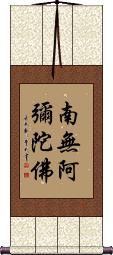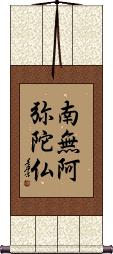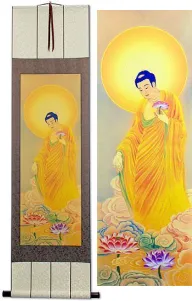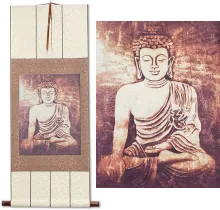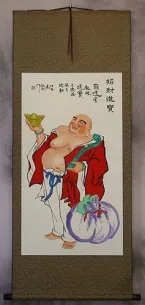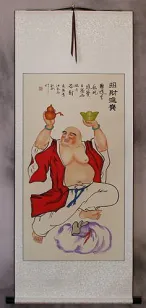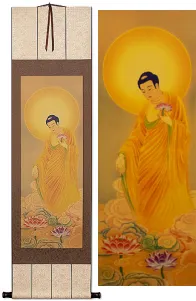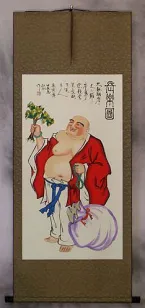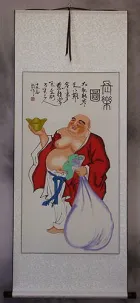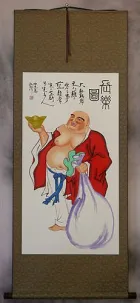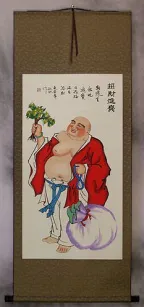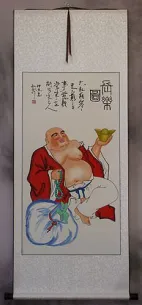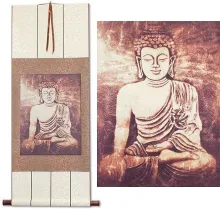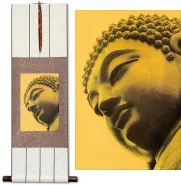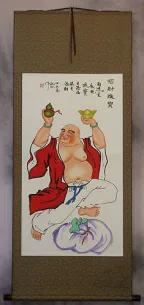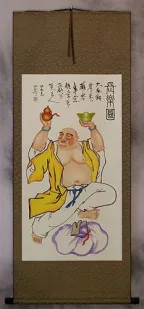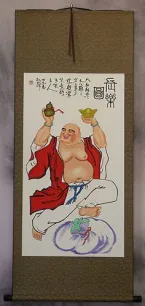Many custom options...
And formats...

Amida Buddha in Chinese / Japanese...
Buy an Amida Buddha calligraphy wall scroll here!
Personalize your custom “Amida Buddha” project by clicking the button next to your favorite “Amida Buddha” title below...
Namo Amitabha Buddha
南無阿彌陀佛 is how to express “The Compassionate Amitabha Buddha” (especially for the Pure Land Buddhist Sect).
Some will translate as “Homage to Amitâbha Buddha” or “I seek refuge in the Amitâbha Buddha.”
This is valid in Chinese characters, Japanese Kanji, and old Korean Hanja.
Sometimes modern Japanese use a different version of the 4th and last Kanji, but the version shown here is the most universal.
This is used to pay homage to Amitabha Buddha.
See Also: Bodhisattva | Buddhism | Nirvana
Namu Amida Butsu
南無阿弥陀仏 is the modern Japanese version of “Namu Amida Butsu” or “The Compassionate Amitabha Buddha.”
Some will translate this as “I sincerely believe in Amitabha; Lord have mercy on me.”
This phrase especially applies to Japanese Pure Land Buddhists.
There is a universal version using ancient characters (with more strokes) for the 4th and last characters. That version is also used in Chinese, Korean, and occasionally Vietnamese.
This is used to pay homage to Amitabha Buddha.
See Also: Bodhisattva | Buddhism | Nirvana
This in-stock artwork might be what you are looking for, and ships right away...
Gallery Price: $200.00
Your Price: $69.88
Gallery Price: $200.00
Your Price: $69.88
Gallery Price: $200.00
Your Price: $69.88
Gallery Price: $200.00
Your Price: $69.88
Not the results for amida buddha that you were looking for?
Below are some entries from our dictionary that may match your amida buddha search...
| Characters If shown, 2nd row is Simp. Chinese |
Pronunciation Romanization |
Simple Dictionary Definition |
阿彌陀佛 阿弥陀佛 see styles |
ē mí tuó fó e1 mi2 tuo2 fo2 o mi t`o fo o mi to fo Amida butsu |
More info & calligraphy: Amitabha BuddhaAmitâbha Buddha |
南無阿弥陀仏 see styles |
namuamidabutsu なむあみだぶつ |
More info & calligraphy: Namu Amida Butsu |
南無阿彌陀佛 南无阿弥陀佛 see styles |
nán wú ā mí tuó fó nan2 wu2 a1 mi2 tuo2 fo2 nan wu a mi t`o fo nan wu a mi to fo namo amida butsu |
More info & calligraphy: Namo Amitabha Buddha |
口称 see styles |
kushou / kusho くしょう |
{Buddh} (See 念仏・1) chanting the invocation to Amida Buddha |
念仏 see styles |
nenbutsu ねんぶつ |
(n,vs,vi) (1) {Buddh} (See 南無阿弥陀仏) nembutsu; nianfo; the three-word invocation "Namu Amida Butsu" dedicated to the Amitabha Buddha; (n,vs,vi) (2) {Buddh} visualizing a Buddha (in one's mind); (place-name, surname) Nenbutsu |
本願 本愿 see styles |
běn yuàn ben3 yuan4 pen yüan hongan ほんがん |
Amida Buddha's original vow; long-cherished desire; (surname) Hongan pūrvapraṇidhāna. The original vow, or vows, of a Buddha or bodhisattva, e. g. the forty-eight of Amitābha, the twelve of 藥師, etc. |
来迎 see styles |
raikou / raiko らいこう |
(n,vs,vi) coming of Amida Buddha to welcome the spirit of the dead; (surname) Raikou |
阿弥陀 see styles |
amida あみだ |
(1) (Buddhist term) Amitabha (Buddha); Amida; (2) (kana only) (abbreviation) ghostleg lottery; ladder lottery; lottery in which participants trace a line across a lattice pattern to determine the winner; (3) (kana only) (abbreviation) wearing a hat pushed back on one's head; (place-name) Amida |
阿彌陀 阿弥陀 see styles |
ā mí tuó a1 mi2 tuo2 a mi t`o a mi to Amida あみだ |
(out-dated kanji) (1) (Buddhist term) Amitabha (Buddha); Amida; (2) (kana only) (abbreviation) ghostleg lottery; ladder lottery; lottery in which participants trace a line across a lattice pattern to determine the winner; (3) (kana only) (abbreviation) wearing a hat pushed back on one's head (阿彌) amita, boundless, infinite; tr. by 無量 immeasurable. The Buddha of infinite qualities, known as 阿彌陀婆 (or 阿彌陀佛) Amitābha, tr. 無量光 boundless light; 阿彌陀廋斯Amitāyus, tr. 無量壽 boundless age, or life; and among the esoteric sects Amṛta 甘露 (甘露王) sweet-dew (king). An imaginary being unknown to ancient Buddhism, possibly of Persian or Iranian origin, who has eclipsed the historical Buddha in becoming the most popular divinity in the Mahāyāna pantheon. His name indicates an idealization rather than an historic personality, the idea of eternal light and life. The origin and date of the concept are unknown, but he has always been associated with the west, where in his Paradise, Suikhāvatī, the Western Pure Land, he receives to unbounded happiness all who call upon his name (cf. the Pure Lands 淨土 of Maitreya and Akṣobhya). This is consequent on his forty-eight vows, especially the eighteenth, in which he vows to refuse Buddhahood until he has saved all living beings to his Paradise, except those who had committed the five unpardonable sins, or were guilty of blasphemy against the Faith. While his Paradise is theoretically only a stage on the way to rebirth in the final joys of nirvana, it is popularly considered as the final resting-place of those who cry na-mo a-mi-to-fo, or blessed be, or adoration to, Amita Buddha. The 淨土 Pure-land (Jap. Jōdo) sect is especially devoted to this cult, which arises chiefly out of the Sukhāvatīvyūha, but Amita is referred to in many other texts and recognized, with differing interpretations and emphasis, by the other sects. Eitel attributes the first preaching of the dogma to 'a priest from Tokhara' in A. D.147, and says that Faxian and Xuanzang make no mention of the cult. But the Chinese pilgrim 慧日Huiri says he found it prevalent in India 702-719. The first translation of the Amitāyus Sutra, circa A.D. 223-253, had disappeared when the Kaiyuan catalogue was compiled A.D. 730. The eighteenth vow occurs in the tr. by Dharmarakṣa A.D. 308. With Amita is closely associated Avalokiteśvara, who is also considered as his incarnation, and appears crowned with, or bearing the image of Amita. In the trinity of Amita, Avalokiteśvara appears on his left and Mahāsthāmaprāpta on his right. Another group, of five, includes Kṣitigarbha and Nāgārjuna, the latter counted as the second patriarch of the Pure Land sect. One who calls on the name of Amitābha is styled 阿彌陀聖 a saint of Amitābha. Amitābha is one of the Five 'dhyāni buddhas' 五佛, q.v. He has many titles, amongst which are the following twelve relating to him as Buddha of light, also his title of eternal life: 無量光佛Buddha of boundless light; 無邊光佛 Buddha of unlimited light; 無礙光佛 Buddha of irresistible light; 無對光佛 Buddha of incomparable light; 燄王光佛 Buddha of yama or flame-king light; 淸淨光佛 Buddha of pure light; 歡喜光佛 Buddha of joyous light; 智慧光佛 Buddha of wisdom light; 不斷光佛 Buddha of unending light; 難思光佛 Buddha of inconceivable light; 無稱光佛Buddha of indescribable light; 超日月光佛 Buddha of light surpassing that of sun and moon; 無量壽 Buddha of boundless age. As buddha he has, of course, all the attributes of a buddha, including the trikāya, or 法報化身, about which in re Amita there are differences of opinion in the various schools. His esoteric germ-letter is hrīḥ, and he has specific manual-signs. Cf. 阿彌陀經, of which with commentaries there are numerous editions. |
別時念仏 see styles |
betsujinenbutsu べつじねんぶつ |
{Buddh} recitation of Amida Buddha's name on a specified day and time period (practice of Pure Land Buddhists) |
口称念仏 see styles |
kushounenbutsu / kushonenbutsu くしょうねんぶつ |
{Buddh} (See 観念念仏) chanting an invocation (to Amida Buddha); reciting a prayer |
念仏三昧 see styles |
nenbutsuzanmai ねんぶつざんまい |
(yoji) {Buddh} being deep in prayer; praying devoutly to Amida Buddha |
観念念仏 see styles |
kannennenbutsu かんねんねんぶつ |
{Buddh} (See 口称念仏) contemplation (on Amida Buddha, the Pure Land, etc.) |
阿弥陀如来 see styles |
amidanyorai あみだにょらい |
{Buddh} Amitabha Tathagata; Amithaba; (person) Amida Nyorai; Amitabha Buddha |
Variations: |
amida あみだ |
(1) {Buddh} Amitabha (Buddha); Amida; (2) (kana only) (abbreviation) (See 阿弥陀くじ) ghostleg lottery; ladder lottery; lottery in which participants trace a line across a lattice pattern to determine the winner; (3) (kana only) (abbreviation) (See 阿弥陀被り) wearing a hat pushed back on one's head |
Variations: |
namuamidabutsu なむあみだぶつ |
(expression) {Buddh} (prayer for rebirth in the Pure Land of Amitabha) (See 浄土) Namu Amida Butsu; Hail Amitabha Buddha; Homage to Amida Buddha |
The following table may be helpful for those studying Chinese or Japanese...
| Title | Characters | Romaji (Romanized Japanese) | Various forms of Romanized Chinese | |
| Namo Amitabha Buddha | 南無阿彌陀佛 南无阿弥陀佛 | na mu a mi da butsu namuamidabutsu | nā mó ē mí tuó fó na1 mo2 e1 mi2 tuo2 fo2 na mo e mi tuo fo namoemituofo | na mo o mi t`o fo namoomitofo na mo o mi to fo |
| Namu Amida Butsu | 南無阿弥陀仏 | namu amida butsu namuamidabutsu | ||
| In some entries above you will see that characters have different versions above and below a line. In these cases, the characters above the line are Traditional Chinese, while the ones below are Simplified Chinese. | ||||
Successful Chinese Character and Japanese Kanji calligraphy searches within the last few hours...
